Wednesday, December 28, 2005
Sunday, December 25, 2005
Christmas Eve, Silent Night? Nope------BOOM!
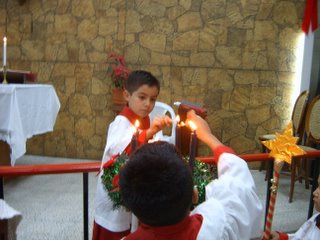 Lighting the Advent Wreath before the Christmas Eve misa, good practice for the firecrackers later that night.
Lighting the Advent Wreath before the Christmas Eve misa, good practice for the firecrackers later that night.Christmas Eve was awesome and loud, very very loud. Fireworks are big here on Christmas and yes, I hit up the stands, which were numerous in the city and loaded up on my share of dangerous minor explosives to celebrate and welcome in Christmas Day.
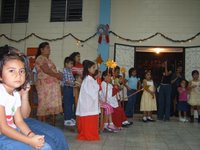 It was a joyous celebration, I'd have to say much more joyous and happy than Christmas in the states tends to be and not so caught up in commercialism, thankfully. Christmas Eve was about being with friends and family to Celebrate the birth of Christ, loudly. Amy pretty much had to yell out the Eucharistic prayer, "El Señor...Boom!...sea...Boom!....con....Boom!.....uste--des!!!!.....Boom!Boom!Boom!"
It was a joyous celebration, I'd have to say much more joyous and happy than Christmas in the states tends to be and not so caught up in commercialism, thankfully. Christmas Eve was about being with friends and family to Celebrate the birth of Christ, loudly. Amy pretty much had to yell out the Eucharistic prayer, "El Señor...Boom!...sea...Boom!....con....Boom!.....uste--des!!!!.....Boom!Boom!Boom!" We're not talking little lightweight wimpy American fireworks here. I saw kids lighting off firecrackers about the size of sticks of dynamite.
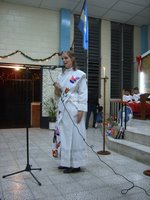 After the service we were invited to the Senior Warden's house for Salvadoran tamales, different than the Mexican tamales I grew up with, dodging fireworks along the way, and after returning home, sat around sipping Flor de Caña Rum( made from sugar cane flowers). We then opened a few presents, then at midnight, with the rest of the city it seemed, lit off fireworks. I've never seen anything like it, the noise was incredible. I did miss my family vey much (Most of Amy's family was here for
After the service we were invited to the Senior Warden's house for Salvadoran tamales, different than the Mexican tamales I grew up with, dodging fireworks along the way, and after returning home, sat around sipping Flor de Caña Rum( made from sugar cane flowers). We then opened a few presents, then at midnight, with the rest of the city it seemed, lit off fireworks. I've never seen anything like it, the noise was incredible. I did miss my family vey much (Most of Amy's family was here for the ordination) but had a great time and look forward to next years celebration.
the ordination) but had a great time and look forward to next years celebration.Vince Right: kids from church light off some tamer fireworks for a change of pace.
 Above: Audrey attempts to send off a Silbadore
Above: Audrey attempts to send off a SilbadoreMonday, December 19, 2005
The Neighborhood
We thought we'd take some time and describe the neighborhood around the church a bit more. It is a mix of poor working class and extremely poor people with a high level of gang violence in amongst, and surrounding, the neighborhood. Soyapango, the city in which the colonia Amatepec sits has the second highest rate of gang activity in the country. Lourdes, a city just outside of San Salvador, has the highest, though lately, it seems San Martin may unfortunately be steadily moving toward that designation. There, if the kids from the church enter the plaza in town, they will be killed by the gang that claims that territory because the kids are from a rival gang's territory. It doesn't matter that the kids do not belong to the gang who claims the territory where the church sits, just being from that area is enough.
In Amatepec, the area where the church sits is considered neutral for the time being. There is one gang territory above the church-Mara Salvatrucha and one below the church Calle 18. The narrow strip in between is nuetral and is where the church sits. Within the past few months near the church and surrounding streets, 10 people have been killed due to gang violence, 6 in a span of three days, which gave rise to a protest march against violence which Amy participated in with the Catholic and Lutheran clergy in the area--three of the people murdered were members of the nearby Catholic church. Some were family members of gang members killed in retaliation, others where drug addicts who crossed the gangs, some were gang members, and some were cobradors(money changers on the buses) and bus drivers--shot either during robbery attempts or for refusing to pay "renta", ransom, for going through gang territory. The buses in Amatepec are notorious for getting robbed by the gangs. Not surprisingly, the rise of the "mara" or gang problem here, which is enormous, has U.S. roots. Over the past years the U.S. government has had a policy of deporting Salvadoran gang members who grew up in the U.S., and have been arrested, back to El Salvador. Many are the children of refugees who fled with their families to the U.S. during the war, though they were never officially given refugee status by the Reagan administration because in the eyes of the Reagan administration they were not fleeing a tyrannical or dictatorial government at odds with the U.S. I guess U.S. trained death squads attacking your village were not considered a great enough threat to one's well being. The two main gangs Mara Salvatrucha and Calle 18 were formed in the U.S. in L.A. where they learned their vicious tactics and were imported with the aid of the U.S. government back into El Salvador. The reaction against them has been violent and has had an adverse effect on the youth, especially in a colonia like Amatepec where all young people are viewed by the police as possible gang members and treated as such. The youth in our church would actually like us to make cards for them that show that they are members of the church so they can easily let the police know that they are not gang members. They are routinely frisked and asked to remove their shirts, where the police look for tatoos, a sign of membership in a gang. All members of our youth group have been approached by the gangs and have said that it has been communication with their parents and involvement in the church that has kept them out. Though in some areas, the gangs have now taken to shooting kids who refuse to join.
Yet it is not all darkness in the neighborhood. It is a very vibrant place with vibrant hard working people. People who have been through alot and have an incredible resiliency about them. The neighborhood is made up of mostly refugees and ex-guerillas from the war. Due to this it seems, the government tends to neglect the area, except after the spats of violence (now on the corners are military soldiers with M-16 rifles, and the police have been checking the buses for gang members) and basic things such as reliable water service and utility service are spotty. The neighborhood is not that far from rural El Salvador, so we see cows wander in from time to time and eat at the piles of garbage that tend to accumulate along the street and from the church you can see the hillsides lined with rows of corn. It is a close community where even the thieves and drug addicts seem to be known by people, and in a way, accepted as part of the community. Tiendas dot the street and you can get fresh tortillas at a little store across the street from the church and pupusas at a little stall further down the street. It's a very rough area, but full of life and it is in these places such as Amatepec, San Martin, or Ilopango, where Santa Maria Virgen sits, in amidst the darkness of violence and poverty, that God is raising up a church full of life and vibrancy.
Vince
Sunday, December 18, 2005
Santa María Vírgen
 Inside the sanctuary.
Inside the sanctuary.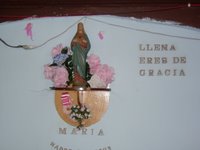 Statue of Mary inside the church.
Statue of Mary inside the church.
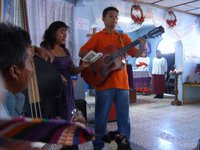 Members of the musical ensemble at Santa Maria Virgen
Members of the musical ensemble at Santa Maria Virgen
Today I had the priviledge of officiating at the Anglican church in El Salvador dedicated to St. Mary, on the fourth Sunday of Advent, with the beautiful Gospel reading from St. Luke on the Annunciation. There were only 50 congregants today--usually Santa María Vírgen has a hundred or more crowded into one of our smallest sanctuaries, actually a house with its interior walls knocked out-- but perhaps the smaller service contributed to the sense of peace and holiness in the celebration. I took the service today for Padre German López, a dynamic veteran priest who is in charge not only of Santa María, one of our fastest-growing churches, but also of three missions in Usulutan along the Lempa River. Padre German and a number of congregants went to Usulutan today (along with my sister Robin and David Starr+) to help in a major celebration of one of these communities-- the anniversary of its founding after the war. But at Santa María we sang (Vince mentions their incredible music ministrybelow--we had a five-piece musical ensemble today, despite the fact that the leaders had gone to Usulutan-- Vince's said after, "This is the second string??"), and prayed, heard scripture (with a dog stretching on the floor during the readings) and meditated on it, and received the Body and Blood of Christ. Santa María is one of the oldest Anglican-Episcopal congregations in the country, and the bishop is looking for someone to help finance the construction of a new church building for them-- a national sancturary dedicated to the Virgen María. Tamales after the service
Tamales after the service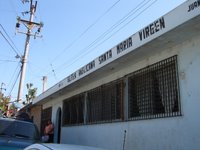 Santa María from the street
Santa María from the street
Saturday, December 10, 2005
Guitar Workshop



Top: Members from various congregations work on chord changes. Middle :Music Director, Mario, from Iglesia Santa Maria Virgen leads
a small group on the basics of guitar.
Bottom: Members from various congregations work on chord changes.
Bottom-Chord changes 1 y 2 y 3 y 4!
On Saturday we held the first all day guitar workshop for the diocese and had a great time. The Bishop has set a goal of having at least two church musicians in every church and mission, and it looks like we are on our way. The students exceeded all expectations, since beginning to learn to play an instrument can be very difficult and frustrating, but all attendees hung tough, and by the end, were strumming the first few bars of Pescador de Hombres. I gave the more advanced players some exercises and techniques to chew on and incorporate into their playing. It's an exciting time, since what music the diocese does have, mainly at Santa Maria Virgen and San Mateo, has an incredible energy to it. Hopefully all I'll be doing is feeding a fire that'll turn into a blaze. A local luthier we discovered down in the depths of El Centro, the chaotic, somewhat dangerous, mercado down in the center of the city, is currently making guitars for all the churches and missions in the diocese which will be paid for by a grant we received from CDSP. Thank you CDSP! We plan on posting pictures of the guitars and luthier's workshop soon. -Vince


